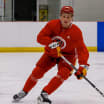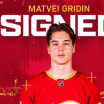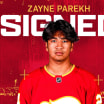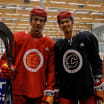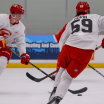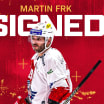Rasmus Andersson isn't much of a numbers guy.
Whether he tops 24 minutes, has three points of his own, or is named the game's first, second or third star is largely irrelevant to him.
But there's a reason the Flames are on a season-long eight-game winning streak, and are now only two off the franchise record for consecutive victories.
BEAST MODE
Andersson putting on a clinic right now with well-rounded game
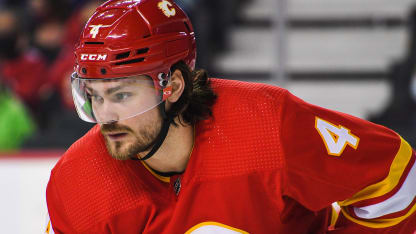
It's because what we saw from No. 4 Wednesday is no one-off.
He was a beast - and has been all year.
"Obviously, everything's a lot easier when you're on a roll and the team's winning games," Andersson said, downplaying the role he's had in making this a first-place team. "I mean, look. We're leading the division and playing some really good hockey.
"But I knew I needed to be better. Everywhere.
"Last year, I had the opportunity to be on the first-unit powerplay, but I didn't really take it. I knew if I got the opportunity again, I told myself that I needed to take full advantage of it. I can definitely be better there, but it's been a good run.
"Coming into this year … I mean, I always have high expectations of myself, but I knew I could play better and be more consistent.
"And it's been a good start."
That's putting it mildly.
In a season chock-full of savory storylines, Andersson's 'awakening' is right near the top.
He's playing big minutes, as told by a chart-topping 24:27 last night that included five minutes of powerplay time, and a shade under three on a penalty-kill that stymied all five Anaheim chances. Overall, he's the pack leader in average even-strength ice time, patrolling the backend for a mean of 17:44 per, and doing so with only a 51.36% offensive zone-start percentage.
Only Chris Tanev has a more difficult, defensive assignment.
He's also putting up offence - quietly surpassing his previous career high in points (22), and is on pace for 47 points if he plays all 82 games this year.
There isn't one part of the game that Andersson isn't flourishing in right now.
"When you look at the way Ras first started his pro career in the minors, he would never have been able to handle more minutes," said Assistant Coach Ryan Huska, who looks after the defenceman. "Part of his development has been learning how to take care of himself in situations where he can do that. It's nice to see him understanding that.
"A lot of what you put into your body will allow you to be more effective in certain situations like that.
"He's growing.
"Growing as a pro, in a lot of different ways."
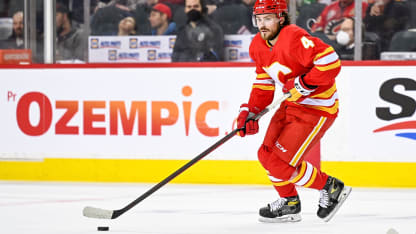
Coaches and players often talk about the need to look after your own end first. That, they say, will lead to more offence. It's one of the more widely used terms around the Flames' locker-room this year, but it truly encapsulates why Andersson has had such a strong campaign.
He's assertive with the puck, his gaps are tight, and his play in transition has been the sparkplug for everything else in his game.
"We always talk about moving the puck as quick defencemen," Andersson said. "When we do that - when we get it into the hands of our forwards - we have a lot of success. That's a big part of us winning games the way we are right now.
"Move it up quick and let the forwards do their thing. And if we get it back at the point, we've talked about getting more shots to the net, and that's what we've been doing lately.
"If you look at the last 10 games, everyone in our D core has been getting points."
It's true. If you look at the winning streak - where the Flames have outscored their opponents by a retina-searing 37-13 margin - the backend has been coming up clutch. Combined, they've put up 31 points (8G, 23A), with Andersson accounting for seven himself.
It's not that this WASN'T there in the past, but at 25 and in his fifth year at the NHL level now, his natural progression has allowed him to make strides, clock back into that teenage pedigree and take games over.
"Everything for him, when he's 'on,' starts with his checking game or his details," Huska said. "The quicker that he can get the puck out of our zone, the more effective he is, because he thinks the game well. He knows when to get up in the rush and connect himself with the play.
"What he's added lately is a little more of a shot mentality. We've pushed him for a long time to shoot the puck more because he's got a good shot, and he's starting to do that more. A lot of it, again, starts with his play in our own zone, and that's where he really has to keep his focus, because it leads to so many other things for him.
"There are going to be those nights when you're not seeing what you want to see - you don't see the holes where the puck should be placed and put - and other nights, it seems like there's tons of room to get pucks through. I think, now, he's seeing more daylight, where there's room for him to shoot the puck a little more.
"Sometimes with your defencemen, they think, 'Oh, I don't want to shoot it; there's no traffic in front of the net.' So, then they're late to let it go and it gets blocked. I think Ras is starting to understand when to shoot, how to shoot more often, and maybe more importantly, how to position his body, too."
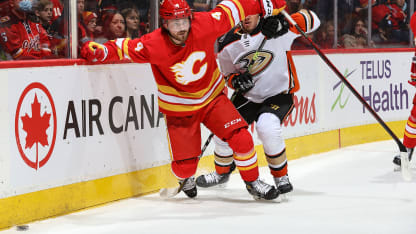
Of course, these opportunities don't happen at all if the team doesn't play as a 'five-man unit' at both ends of the ice.
In fact, it's that very philosophy that's led to the Flames' exceptional play in transition this year. By having the forwards come back and pressure the attackers, it allows Calgary's blueliners to not only keep a tight gap, but stand up at the line, kill plays and create turnovers.
From there, they go on the attack.
As one.
"Sometimes with defencemen, they get soft with their gaps," Huska said. "Sometimes, that's a little bit of laziness on their part. But if teams continually come at you and they don't have a lot of guys squeezing them from the outside, you start to back off the line a little bit and that opens up the gap.
"If you look at our team this year, we haven't had that issue because our forwards have been really committed. And it makes it so much easier on the defencemen. So, now typically, if the gap is poor, it's not on the forwards - it's on the defenceman.
"They understand that, they know how much of our game plan revolves around being connected as five guys. They have to stay tight with the forwards as we're moving up into the offensive zone, in the same way that our forwards have to stay tight to our defencemen when we're coming back into our zone.
"It's been much better this year and I think it's helped us in our checking game - and when you look at Rasmus' year as a whole, you can definitely see a real change."
Andersson agrees.
But as the ultimate team guy, the limelight, in his mind, is more of a shared space. He knows that with 35 games left and hopefully a long playoff run ahead of them, they can't be getting complacent.
Not that he ever has.
"This is the fun part," Andersson said. "When you're coming to the rink, you've won a few games in a row and you're having success as a team, this is why you play.
"For me?
"I'm just trying to do my part."

